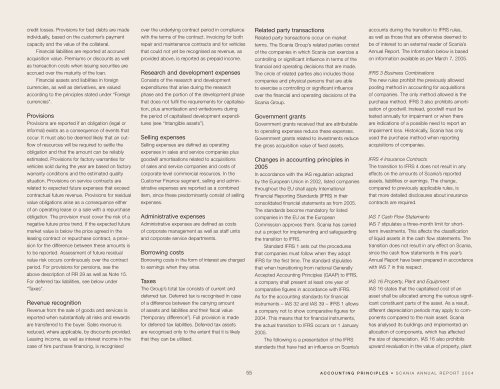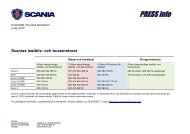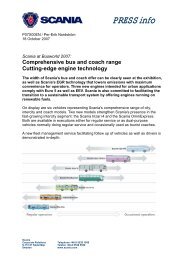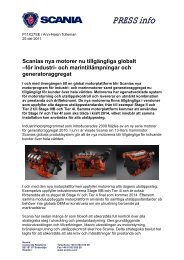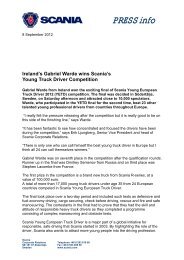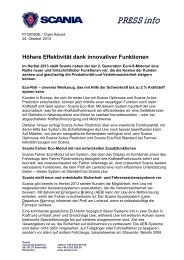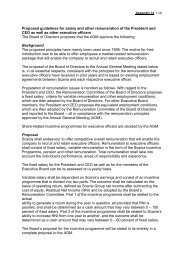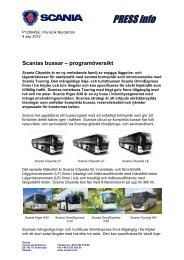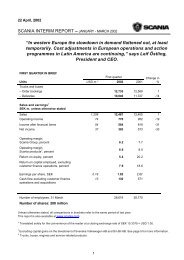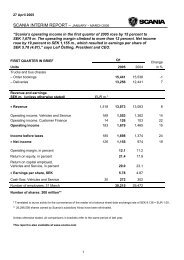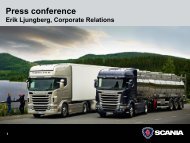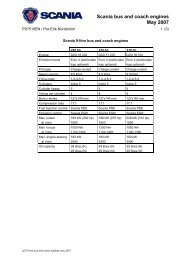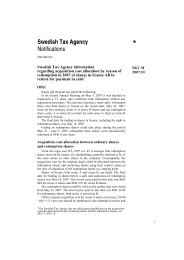Scania annual report 2004
Scania annual report 2004
Scania annual report 2004
Create successful ePaper yourself
Turn your PDF publications into a flip-book with our unique Google optimized e-Paper software.
credit losses. Provisions for bad debts are made<br />
individually, based on the customer’s payment<br />
capacity and the value of the collateral.<br />
Financial liabilities are <strong>report</strong>ed at accrued<br />
acquisition value. Premiums or discounts as well<br />
as transaction costs when issuing securities are<br />
accrued over the maturity of the loan.<br />
Financial assets and liabilities in foreign<br />
currencies, as well as derivatives, are valued<br />
according to the principles stated under “Foreign<br />
currencies”.<br />
Provisions<br />
Provisions are <strong>report</strong>ed if an obligation (legal or<br />
informal) exists as a consequence of events that<br />
occur. It must also be deemed likely that an outflow<br />
of resources will be required to settle the<br />
obligation and that the amount can be reliably<br />
estimated. Provisions for factory warranties for<br />
vehicles sold during the year are based on factory<br />
warranty conditions and the estimated quality<br />
situation. Provisions on service contracts are<br />
related to expected future expenses that exceed<br />
contractual future revenue. Provisions for residual<br />
value obligations arise as a consequence either<br />
of an operating lease or a sale with a repurchase<br />
obligation. The provision must cover the risk of a<br />
negative future price trend. If the expected future<br />
market value is below the price agreed in the<br />
leasing contract or repurchase contract, a provision<br />
for the difference between these amounts is<br />
to be <strong>report</strong>ed. Assessment of future residual<br />
value risk occurs continuously over the contract<br />
period. For provisions for pensions, see the<br />
above description of RR 29 as well as Note 15.<br />
For deferred tax liabilities, see below under<br />
“Taxes”.<br />
Revenue recognition<br />
Revenue from the sale of goods and services is<br />
<strong>report</strong>ed when substantially all risks and rewards<br />
are transferred to the buyer. Sales revenue is<br />
reduced, where applicable, by discounts provided.<br />
Leasing income, as well as interest income in the<br />
case of hire purchase financing, is recognised<br />
over the underlying contract period in compliance<br />
with the terms of the contract. Invoicing for both<br />
repair and maintenance contracts and for vehicles<br />
that could not yet be recognised as revenue, as<br />
provided above, is <strong>report</strong>ed as prepaid income.<br />
Research and development expenses<br />
Consists of the research and development<br />
expenditures that arise during the research<br />
phase and the portion of the development phase<br />
that does not fulfil the requirements for capitalisation,<br />
plus amortisation and writedowns during<br />
the period of capitalised development expenditures<br />
(see “Intangible assets”).<br />
Selling expenses<br />
Selling expenses are defined as operating<br />
expenses in sales and service companies plus<br />
goodwill amortisations related to acquisitions<br />
of sales and service companies and costs of<br />
corporate-level commercial resources. In the<br />
Customer Finance segment, selling and administrative<br />
expenses are <strong>report</strong>ed as a combined<br />
item, since these predominantly consist of selling<br />
expenses.<br />
Administrative expenses<br />
Administrative expenses are defined as costs<br />
of corporate management as well as staff units<br />
and corporate service departments.<br />
Borrowing costs<br />
Borrowing costs in the form of interest are charged<br />
to earnings when they arise.<br />
Taxes<br />
The Group’s total tax consists of current and<br />
deferred tax. Deferred tax is recognised in case<br />
of a difference between the carrying amount<br />
of assets and liabilities and their fiscal value<br />
(“temporary difference”). Full provision is made<br />
for deferred tax liabilities. Deferred tax assets<br />
are recognised only to the extent that it is likely<br />
that they can be utilised.<br />
Related party transactions<br />
Related party transactions occur on market<br />
terms. The <strong>Scania</strong> Group’s related parties consist<br />
of the companies in which <strong>Scania</strong> can exercise a<br />
controlling or significant influence in terms of the<br />
financial and operating decisions that are made.<br />
The circle of related parties also includes those<br />
companies and physical persons that are able<br />
to exercise a controlling or significant influence<br />
over the financial and operating decisions of the<br />
<strong>Scania</strong> Group.<br />
Government grants<br />
Government grants received that are attributable<br />
to operating expenses reduce these expenses.<br />
Government grants related to investments reduce<br />
the gross acquisition value of fixed assets.<br />
Changes in accounting principles in<br />
2005<br />
In accordance with the IAS regulation adopted<br />
by the European Union in 2002, listed companies<br />
throughout the EU shall apply International<br />
Financial Reporting Standards (IFRS) in their<br />
consolidated financial statements as from 2005.<br />
The standards become mandatory for listed<br />
companies in the EU as the European<br />
Commission approves them. <strong>Scania</strong> has carried<br />
out a project for implementing and safeguarding<br />
the transition to IFRS.<br />
Standard IFRS 1 sets out the procedures<br />
that companies must follow when they adopt<br />
IFRS for the first time. The standard stipulates<br />
that when transitioning from national Generally<br />
Accepted Accounting Principles (GAAP) to IFRS,<br />
a company shall present at least one year of<br />
comparative figures in accordance with IFRS.<br />
As for the accounting standards for financial<br />
instruments – IAS 32 and IAS 39 – IFRS 1 allows<br />
a company not to show comparative figures for<br />
<strong>2004</strong>. This means that for financial instruments,<br />
the actual transition to IFRS occurs on 1 January<br />
2005.<br />
The following is a presentation of the IFRS<br />
standards that have had an influence on <strong>Scania</strong>’s<br />
accounts during the transition to IFRS rules,<br />
as well as those that are otherwise deemed to<br />
be of interest to an external reader of <strong>Scania</strong>’s<br />
Annual Report. The information below is based<br />
on information available as per March 7, 2005.<br />
IFRS 3 Business Combinations<br />
The new rules prohibit the previously allowed<br />
pooling method in accounting for acquisitions<br />
of companies. The only method allowed is the<br />
purchase method. IFRS 3 also prohibits amortisation<br />
of goodwill. Instead, goodwill must be<br />
tested <strong>annual</strong>ly for impairment or when there<br />
are indications of a possible need to <strong>report</strong> an<br />
impairment loss. Historically, <strong>Scania</strong> has only<br />
used the purchase method when <strong>report</strong>ing<br />
acquisitions of companies.<br />
IFRS 4 Insurance Contracts<br />
The transition to IFRS 4 does not result in any<br />
effects on the amounts of <strong>Scania</strong>’s <strong>report</strong>ed<br />
assets, liabilities or earnings. The change,<br />
compared to previously applicable rules, is<br />
that more detailed disclosures about insurance<br />
contracts are required.<br />
IAS 7 Cash Flow Statements<br />
IAS 7 stipulates a three-month limit for shortterm<br />
investments. This affects the classification<br />
of liquid assets in the cash flow statements. The<br />
transition does not result in any effect on <strong>Scania</strong>,<br />
since the cash flow statements in this year’s<br />
Annual Report have been prepared in accordance<br />
with IAS 7 in this respect.<br />
IAS 16 Property, Plant and Equipment<br />
IAS 16 states that the capitalised cost of an<br />
asset shall be allocated among the various significant<br />
constituent parts of the asset. As a result,<br />
different depreciation periods may apply to components<br />
compared to the main asset. <strong>Scania</strong><br />
has analysed its buildings and implemented an<br />
allocation of components, which has affected<br />
the size of depreciation. IAS 16 also prohibits<br />
upward revaluation in the value of property, plant<br />
55 ACCOUNTING PRINCIPLES • SCANIA ANNUAL REPORT <strong>2004</strong>


